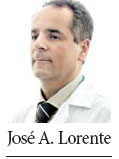Finding lost children through their genes
Updated: 2012-08-19 07:57
By Suzanne Daley(The New York Times)
|
|||||||||
GRANADA, Spain - It was more than a decade ago, as his taxi made its way through the troubled neighborhoods of Lima, Peru, that Dr. Jose A. Lorente, an expert in forensic genetics, first started thinking about the plight of street children.
In Peru to consult with police officials about identifying the bodies of some terrorists, he could not help asking them what they did to help the children. The police told him there was little they could do. There was no way to identify them, no way to reunite them with their families and usually they just ran away if they were taken to orphanages.
Dr. Lorente was not satisfied with that answer.
"I knew there was a way," he said. "I knew that DNA could do that. And I thought, We can keep track of the pedigree of dogs and racehorses, can't we do as much for children?"
In the 1990s, Dr. Lorente did research at the Federal Bureau of Investigation's training center at Quantico, Virginia, and helped develop ways to match DNA when the sample was badly deteriorated. He has made headlines by helping to identify the remains of Christopher Columbus and Simon Bolivar, and bodies found in mass graves in Chile and elsewhere.

But along the way he has also managed to persuade officials in 16 countries - including Guatemala, Mexico, Peru, Ecuador, Brazil, Nepal, Indonesia, Malaysia, India and Thailand - to begin building DNA databanks that can identify and reunite missing children with their families.
Dr. Lorente, 51, envisages a network of national databanks storing the DNA of parents who have lost children. That way when children are found, even years later, they can be matched. He also sees such databanks as playing a crucial role in preventing the adoptions of stolen children and in dismantling trafficking rings.
"This is all doable, and we should be doing it," Dr. Lorente said.
The foundation he set up, DNA-Prokids, has been providing countries with thousands of free DNA tests and DNA collection kits. So far, he says, the free tests have been used in reuniting about 550 children with their families, most of them in Guatemala and Peru. The tests have also stopped more than 200 illegal adoptions.
Dr. Lorente believes that adoptions should always involve genetic testing to make sure the parents giving away the child are really the parents. And he says that 80 percent of the world's street children have families who would gladly take them back if they could be found.
Dr. Lorente says there is a real excitement to working on cases like identifying the remains of Columbus and Bolivar. But it is the more intimate cases that stay with him longer. "When you can look at a mother and you can say, 'O.K., we have found your son's body,'" he said, "that, for me, is huge."
Until recently, he had not met any of the families DNA-Prokids helped reunite. But the company that developed some of the test kits decided to make a promotional video and flew him to California to meet Brenda Corado, who had been reunited with her daughter, Angela, in Guatemala.
Ms. Corado had been walking on the street with Angela, then 21 days old, when two men got out of a car, snatched the baby from her arms and beat her until she passed out. What the men intended to do with the child is unclear. But Dr. Lorente believes that they probably intended to make money putting the child up for adoption.
Two months later, however, an infant girl was abandoned at a Christian television station in Guatemala and, using DNA analysis, the police were able to identify that baby as Angela.
"I just saw how she looked," Dr. Lorente said of his first meeting with Ms. Corado. "What could she say? You don't make money at this. But you do feel proud."
Rachel Chaundler contributed reporting.
The New York Times
(China Daily 08/19/2012 page11)